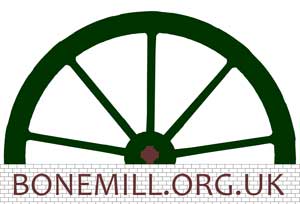In September 2018 a new notice board frame was made and installed by Fred Munford in the style of the gate frame arch over the sluice gate. This houses our information sign on the Nar Valley Way footpath telling the story of the bone mill. Like the gate frame, the notice board has mellowed with age to a more natural colour.
We have a box of cards mounted on the notice board frame so walkers can take one and view the website. We put notices on the frame about our volunteer recruitment and open days. There are copies of the sign in the visitor centre and railway wagon.
The pictures around the sign, clockwise from top right are: Human Skull, Elevator Hopper, Tunnel Exit, 1854 Layout Plan, Cistern chamber, 1924 and 1880 photos.
The sign text reads:
This is the site of Narborough Bone Mill built by the Mariott Brothers in the 1830s. The brothers also owned the Narborough Maltings. Bones from local slaughterhouses, whale bones from Kings Lynn, coprolites from West Dereham and human bones from Europe were brought to the site and ground down for fertilizer. The mill closed in the 1890s as it became uneconomical to run due to a falling demand for phosphate fertilizer.
In 2015 the site received a £92,000 Heritage Lottery grant to preserve the remains of the mill. Much of the grant was used to repair the remaining brickwork and to replace the rusted water wheel buckets. Many of the buckets are original as despite being exposed to the elements for over 100 years they were in very good condition.
As confirmation that human bones from Northern Europe were brought to the mill part of a human skull was found on site. It has been confirmed as human and radiocarbon dated to 1218 AD.
The main building had three floors, with two pairs of grindstones on the ground floor. The remains of a bucket and chain elevator were discovered below the ground near the water wheel. This was used to convey the ground bones to the top floor for bagging.
The mill has a central relief channel where water was routed through tunnels ending in an open channel in the centre of the mill complex. Large quantities of water were required for the bone boiling process which cleaned the bones ready for grinding.
There is a well preserved underground chamber which is believed to be water storage for a steam engine. Coal was in good supply and an engine would have enabled the mill to keep running when low water levels in the lock stopped the water wheel. This would have been a frequent occurrence as barges passed through en route to the Maltings complex upstream.
In Loving Memory of Robin Munford
Large Picture of Sign Interactive Plan Gate Frame Site Activity Feature Boards Blog 29/9/18











